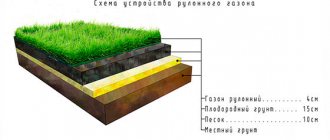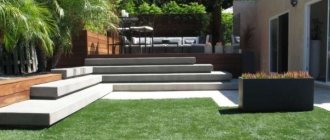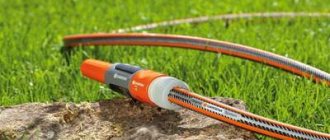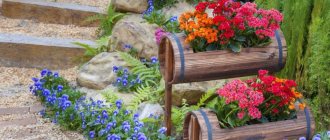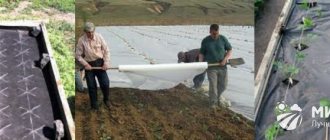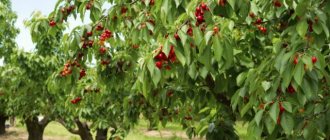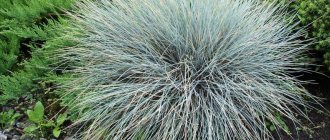Owners of private and country houses are interested in equipping their estate as best as possible. Following internal impulses, owners strive to plant landscaping and give them an aristocratic appearance. This can be done using rolled lawns.
A green carpet makes the area neat, emphasizes the beauty of paths and flower beds, and creates a feeling of extraordinary harmony. Densely planted grass reduces the growth of weeds, improves the microclimate, and gives the garden a well-groomed appearance.
Advantages of rolled lawn
The finished turf has the following advantages:
- landscaping of the site occurs in a short time (several hours or days depending on the area);
- can be laid on the most problematic soils (rocky, etc.);
- does not require special care;
- has a high decorative effect;
- allows mechanical stress after a week;
- can be laid on slopes and relief terrain;
- creates an even grass cover that does not contain weeds.
Due to the large number of positive aspects, artificial lawns are in demand (both for landscaping private and urban areas).
Maintaining a Finished Lawn
Your new green miracle is very unpretentious and takes root well. We will organize the first haircut in the spring. Moreover, it is necessary to mow in two stages: first the tops of the stems, and then finally at the desired height. To prevent the appearance of weeds, periodically treat with herbicides.
Water gently as needed. Both drought and waterlogging are unacceptable.
- How to make an alpine slide in a small area with your own hands in 8 steps
- How to make a pond at your dacha with your own hands
Autumn whitewashing of trees: why, when and how to whitewash trees
Varieties
The composition of any lawn includes fescue, bentgrass or hedgehog grass. There are many varieties of these herbs. There are even varieties with dense, wide foliage, reaching 0.9 m in height.
The plant variety is selected depending on the weather conditions of the region. On average, artificial turf reaches 0.4 m in width and 2 m in length. The thickness is 8-10 cm.
Below are the most popular types of artificial lawns. However, there are others with a narrower purpose. For example, Moorish (blooming), urban and others.
The most affordable type is the universal type. The ground floor will cost the most, because... it contains elite varieties of plants that require special conditions for cultivation.
Universal
The hardiest type, tolerates dry weather, trampling, and shaded areas well. Suitable for refining difficult areas.
Plants used
Each herb in the roll has its own purpose. Some varieties tolerate dry weather well, others grow quickly, others prevent weeds, etc. To create an artificial lawn, mixtures of the following plants are used:
- bluegrass 60%, fescue 30%, ryegrass 10% (universal);
- fescue 80%, bluegrass 20% (recommended for shaded areas);
- meadow bluegrass 50%, red fescue 25%, ryegrass 25% (tolerates trampling, recovers in a short time, grows evenly).
These are the most popular mixtures, but there are others.
Kinds
Types of rolled lawns are determined by their purpose. The most popular of them are listed in the table.
| Lawn name | Characteristic |
| Universal | The most common type of lawn. Designed for landscaping gardens, park areas, playgrounds, residential areas, and areas of industrial facilities. Its features are decorativeness, resistance to mechanical stress and long service life. When making a universal lawn, seeds of meadow bluegrass, perennial ryegrass and red fescue are used. Such lawns do not experience an increased need for soil fertilization, are unpretentious to weather conditions and are resistant to damping off and lawn diseases (rust, spotting). Before installing a lawn, the ground is cultivated, fertilized and loosened. |
| Sports | Used for football fields, tennis courts and special sports grounds. A characteristic feature of the lawn is the presence of durable compacted turf and a grass mixture of resistant grasses - perennial ryegrass and meadow bluegrass of different varieties. The turf covering is elastic and resistant to trampling. The sports lawn has a luxurious dark green carpet that can easily withstand any load. The grass can withstand high temperatures, is resistant to anthractosis and rust, and is capable of crowding out weeds. |
| Parterre | Laying out such a lawn is advisable in ceremonial places: in front of the facades of houses, commercial buildings, hospitals and schools. It can also be laid along the central alley in the garden. To create a parterre lawn, low grass plants are selected, which allows you to achieve an even, velvety cover. Setting up a lawn requires mandatory soil preparation. In this case, special attention should be paid to weed removal, which involves herbicide treatment. Parterre lawns will not be able to grow in shaded areas. It is fastidious in care: it needs constant fertilizing with fertilizers, timely watering and haircuts. |
| Shadow | Shade-tolerant lawns are laid in parks, in dark places. Specially selected herbs tolerate dark conditions, humidity, and withstand slightly acidic environments. The advantage of a shady lawn is that it is rarely mowed - only once a month. This is due to the slow growth of plants in the shade. Lawn care, watering and fertilization are carried out according to the same rules as for other types of lawns. |
Rolled lawn production technology
Rolled lawn from the manufacturer is produced in several stages:
- Preparing the landing site. It is plowed, milled, leveled. To prevent the growth of weeds, herbicides are applied. Finally, compact it to create a smooth, medium-density soil.
- Marking and installing polymer mesh.
- Filling with a thin layer (2-3 cm) of air and nutrient soil mixture.
- Surface sowing using an automated seeder.
- Compacting the soil. Constant irrigation to maintain moisture. Fertilizers are added along with water.
- Cutting and rolling it into rolls.
It takes about 1.5 years to grow a full-fledged rolled lawn, ready for cutting and transportation. All this time he is carefully looked after. The price for it is not cheap, because... it requires the hard work of many people.
When the rolled grass for the lawn grows a powerful root system, its greenery reaches the desired size, the canvas is cut with a specialized machine, rolled up and transported to a new place.
It is best to carry out installation within 2 days after this. However, in a humid environment, rolls can be kept for up to 4 days.
Because The thickness of the lawn is 8-10 cm; the soil on the site must be removed to the same depth so that the entire surface is at the same height.
How to choose
It is quite possible to choose a high-quality rolled lawn if you follow the advice of experts. Then the coating will last a long time and will delight owners and guests with its appearance.
Important points:
- When purchasing ready-made grass mats, you should pay attention to the root system of the grass: it should be strong and white in color.
- It is assumed that there is a uniform layer of turf with the same thickness, which usually varies from 2 to 4 cm.
- The quality of the soil is of no small importance; it should not contain too much sand or be too clayey. There should also be no stones in the ground.
- Yellowed grass indicates that the lawn is not young. Only a lush green color of the lawn, uniform over the entire area, is allowed.
- The presence of insect pests in lawn layers is unacceptable.
- The height of the carpet should not be more than 3 cm. There should be no empty spaces on it.
- The grass must be evenly distributed over the entire area and must be trimmed. Tall, unmown grass can hide imperfections: bald spots, empty or less dense areas.
- The roll should not have a rotten smell, which appears when lying for a long time without turf.
- You should select a lawn according to your budget. It is recommended to take into account the likelihood of developing allergies to certain types of herbs.
Which lawn would you prefer?
RolledSowing
Laying a lawn yourself is a difficult process that requires a significant amount of time. In private areas, in most cases, you can cope without the use of special equipment. On football fields, sports grounds and city lawns, work is expected to be carried out using agricultural machinery. The duration of such events may vary.
Another way
There is another way without laying a polymer mesh. It is practically no different from the previous one, only the second item from the list above is skipped. Has the following disadvantages:
- at the last stage of production it is necessary to involve specialized equipment;
- thickness may vary, depending on the quality of the soil;
- Thin rolls may fall apart into separate pieces.
Nursery specialists carefully select grass for the lawn and grow it in suitable climatic conditions.
Also, when sowing, the density of the lawn is controlled and herbicides are applied to prevent weeds, the area is ideally leveled, fertilizing is applied if necessary, and watering is regulated.
Where to order
You can order rolled lawn from the nursery. In this case, the buyer can be confident in the freshness of the purchased product. In any case, before paying, you must visually assess the quality of the purchased coating. Installation may only be carried out by qualified workers. The consequence of low professionalism of workers will be uneven coating and damage to the material.
To correctly calculate delivery, you need to know how much a roll of lawn or one full pallet weighs, the amount of material is multiplied by the weight of one unit and, based on this figure, a machine is ordered. It is very convenient to buy rolled lawn with delivery. In this case, one company will be involved in growing, cutting and moving the material. This will save customers a lot of time due to the absence of constant transfers of material between different companies.
You can order rolled lawn from the nursery Source gazontrad.ru
Before purchasing coverage, you need to determine its quantity. To do this, the area of landscaping is measured, the type of covering, the composition of grasses is selected, and, knowing the dimensions of the roll of lawn, you can find out their quantity.
Lawn laying process
Before laying the rolled lawn, you need to prepare the area:
- Plow and plow down about 10 cm.
- Destroy weeds and apply broad-spectrum herbicides.
- Level the ground with a slight slope (3-5 cm) to drain excess water.
- Compact, add nitrogen fertilizer, moisten the substrate.
Artificial lawn grasses prefer soil that is low in acidity. Therefore, if it is high, you need to add peat, wood ash and other similar components.
Plants will grow best on sandy and sandy loam soil. They grow poorly on heavy clay soils, so you need to add sand.
Laying of rolled lawn occurs as follows:
- Lay out the rolls tightly, in a checkerboard pattern, but so that the edges do not extend into the neighboring area.
- Unfold one in a straight line.
- Compact by rolling the roller. This promotes a tighter fit and removes air. The main thing is not to overdo it, so as not to tear the canvas.
- Repeat the same with the remaining rolls.
- After laying the lawn, run a roller across the seams.
- Shape the edges by cutting the sod in a straight line with a sharp knife.
- Water the lawn.
If the area is rounded, you should not try to shift the direction of laying the rolls. The desired shape can only be given at the end using a knife or other sharp tool.
What is the secret of popularity
Rolled “artificial” turf appeared in the 30s of the last century in America. Then many European countries happily continued the tradition of laying a finished grass cloth.
A rolled lawn is a real godsend for all those who do not want to wait long for the grass they have sown on their site to turn green. So-called “turf mats” are formed by sowing lawn grass seeds. They are fixed on a lawn mesh base.
All the buyer needs to do is prepare the site and lay down a “living” rug. After only 10-14 days, the area near the house where the grass cloth was placed will noticeably change.
Summer
Necessary activities:
- in dry weather, water in the evening 1-2 times a week;
- approximately 1 rub. at 7 days, trim the grass so that the height of the grass does not exceed 4-7 cm;
- After every second mowing, apply fertilizer;
- Regularly destroy weeds.
For feeding, you can use Kemira lawn 5 kg per hundred square meters.
Autumn
Fall care activities include:
- at the beginning of September, add potassium (20-30 g per sq.m.) and phosphorus (5-10 g per sq.m.);
- in the absence of rain, water about once a week;
- 20-30 days before the expected first frost, stop cutting;
- Remove plant debris before snow falls.
There is no need to cover the lawn for the winter.
Problems you may encounter
The most common problem: the rolled lawn dries out and turns yellow. Very often this is due to the fact that errors were made during transportation or the formation storage technology was not followed. In addition, many buyers do not know how to properly care for such coating. Many people believe that work on the site is limited to just one planting, and the lawn will grow on its own without needing additional care.
This is far from true. Only weeds can germinate on their own. All other crops and landscaping canvases require careful care. So, if the lawn turns yellow or red (brown) spots appear on the grass, this may be caused by the following errors in work and laying technology:
- The canvas was watered unevenly;
- When laying, the “turf mat” was not sufficiently rolled to the ground, which means it did not dock with the main soil;
- Poor drainage;
- The soil was not properly prepared before planting the lawn.
Over time, other problems may arise. Lawn caretakers often complain that the grass is becoming sparse. Weeds may also appear against the background of yellowed fabric.
The main reason why bald patches appear on the lawn is that there is not enough light. Neighboring buildings, fences, trees, and other structures can constantly cast shadows on the lawn. Also, if the lawn is not mowed and fertilized often enough (especially in the spring), this problem can also arise.
A lawn is a spectacular decoration for any area. However, he is very capricious and requires careful treatment and careful care. If there is no time or opportunity to carry out the appropriate work on the site, it is better to refuse to purchase “living” canvases and purchase synthetic ones.
Spring
Necessary actions:
- After the snow cover melts, remove debris and plant debris with a rake;
- add nitrogen (5 g per sq.m);
- After the grass begins to grow, feed it with potassium and phosphorus in the same dosage as in the fall.
The lawn also needs to be watered if necessary.
How many rolls do you need?
You shouldn’t buy rolls at random; it’s better to pre-calculate the required quantity. To do this, measure the parameters of your site. Having found out the area (in square meters), add another 5% of this area to your calculations. So, for example, if you have a plot of 30 square meters, add another 1.5 square meters. m. This calculation will be relevant for a plot of simple shape, without flower beds, paths, or bends. If they are, it is worth adding another 10% of the total area, since the amount of waste material will increase.
Having understood the square footage of the area, calculate the required number of rolls based on their dimensions, which we have already given above. The area of one roll is 0.8 square meters. m. Knowing this, you can easily calculate the required amount.
Winter
In winter, it is not recommended to walk on the lawn. No additional care required.
Installing an artificially grown lawn helps transform any area in a short time.
Of course, the cost is quite high, but you don’t mind the money if you imagine how much effort, time and nerves would have to be spent on growing a natural lawn.
Working with soil
Before laying a rolled lawn on a cleaned clay surface, it is worth laying a layer of sand and gravel (from 4 to 8 centimeters) on the soil. Even if you don’t need to plant seeds in the soil itself, it’s still worth improving the surface layer of the soil. It needs to be given more fertility, reduce the acidity of the soil, and also improve the structure itself.
There are several ways to improve your lawn soil. One of the simplest and most effective is to apply complex mineral fertilizers at a rate of 50-60 g/m2. All work is carried out in dry sunny weather.
Photo of rolled lawn
Total
Category: Lawns and paths
